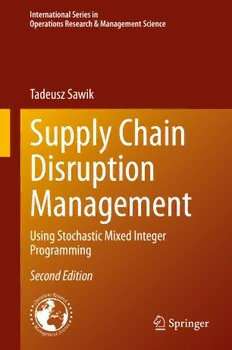Table Of ContentInternational Series in
Operations Research & Management Science
Tadeusz Sawik
Supply Chain
Disruption
Management
Using Stochastic Mixed Integer
Programming
Second Edition
International Series in Operations Research
& Management Science
Volume 291
Editors
CamilleC.Price
DepartmentofComputerScience,StephenF.AustinStateUniversity,
Nacogdoches,TX,USA
AssociateEditor
JoeZhu
FoisieBusinessSchool,WorcesterPolytechnicInstitute,Worcester,MA,USA
FoundingEditor
FrederickS.Hillier
StanfordUniversity,Stanford,CA,USA
Moreinformationaboutthisseriesathttp://www.springer.com/series/6161
Tadeusz Sawik
Supply Chain Disruption
Management
Using Stochastic Mixed Integer Programming
Second Edition
TadeuszSawik
DepartmentofOperationsResearch
AGHUniversityofScienceandTechnology
Krako´w,Poland
DepartmentofEngineering
ReykjavikUniversity
Reykjavik,Iceland
ISSN0884-8289 ISSN2214-7934 (electronic)
InternationalSeriesinOperationsResearch&ManagementScience
ISBN978-3-030-44813-4 ISBN978-3-030-44814-1 (eBook)
https://doi.org/10.1007/978-3-030-44814-1
©TheEditor(s)(ifapplicable)andTheAuthor(s),underexclusivelicensetoSpringerNatureSwitzerland
AG2018,2020
Thisworkissubjecttocopyright.AllrightsaresolelyandexclusivelylicensedbythePublisher,whether
thewholeorpartofthematerialisconcerned,specificallytherightsoftranslation,reprinting,reuse
ofillustrations,recitation,broadcasting,reproductiononmicrofilmsorinanyotherphysicalway,and
transmissionorinformationstorageandretrieval,electronicadaptation,computersoftware,orbysimilar
ordissimilarmethodologynowknownorhereafterdeveloped.
Theuseofgeneraldescriptivenames,registerednames,trademarks,servicemarks,etc.inthispublication
doesnotimply,evenintheabsenceofaspecificstatement,thatsuchnamesareexemptfromtherelevant
protectivelawsandregulationsandthereforefreeforgeneraluse.
Thepublisher,theauthors,andtheeditorsaresafetoassumethattheadviceandinformationinthisbook
arebelievedtobetrueandaccurateatthedateofpublication.Neitherthepublishernortheauthorsor
theeditorsgiveawarranty,expressedorimplied,withrespecttothematerialcontainedhereinorforany
errorsoromissionsthatmayhavebeenmade.Thepublisherremainsneutralwithregardtojurisdictional
claimsinpublishedmapsandinstitutionalaffiliations.
ThisSpringerimprintispublishedbytheregisteredcompanySpringerNatureSwitzerlandAG.
Theregisteredcompanyaddressis:Gewerbestrasse11,6330Cham,Switzerland
ToBartek,Siasia,Kalinka,Aleksander,
Diana,Kajetan-Ragnar,andRokimi
withlove
andtotheMemoryofmyParents
Preface
Scope
This book deals with stochastic combinatorial optimization problems in supply
chain disruption management, with a particular focus on the management of dis-
ruptedflows incustomer-driven supplychains.Theproblems aremodeled usinga
scenario-basedstochasticmixedintegerprogrammingtoaddressrisk-neutral,risk-
averse, and mean-risk decision-making in the presence of supply chain disruption
risks. One of the main objectives of this book is to present a computationally ef-
ficient portfolio approach to integrated decision-making in global supply chains
under disruption risks. In the context of supply chain disruptions, the portfolio is
defined as the allocation of demand for different part types among suppliers and
the allocation of demand for different product types among production facilities
(e.g.,assemblyplants)ofthefinalmanufacturer.Theallocationofdemandforparts
amongsuppliersisdefinedasasupplyportfolio,whereastheallocationofdemand
forproductsamongproductionfacilitiesofthefinalmanufacturerisdefinedasade-
mandorcapacityportfolio.Unlikemostofthereportedresearchonthesupplychain
riskmanagementwhichmainlyfocusesontheriskmitigationdecisionstakenprior
to a disruption, the proposed portfolio approach combines decisions made before,
during, and after the disruption. When a disruption occurs, the primary portfolios
determinedpriortoadisruptionarereplacedbyrecoveryportfolios.Theselection
of portfolios will be combined with the management of disrupted material flows,
i.e.,supply,production,anddistributionschedulingunderdisruptionrisks.Thebook
demonstratesthatthedevelopedportfolioapproachleadstosimpledecision-making
models and, owing to embedded network flow structures, to computationally effi-
cientstochasticmixedintegerprogramswithastrongLPrelaxation.
Moreover,
• integratedvs.hierarchicaldecision-makingiscompareddependingontheavail-
ableinformationondisruptionevents;
vii
viii Preface
• amulti-objectivedecision-makingisanalyzedtotradeoffbetween:costvs.ser-
vicelevelobjectivefunctions,fairnessvs.non-equitabilityofobjectivefunctions,
averagevs.worst-caseperformanceofasupplychain,etc.;
• a multi-period decision-making is modeled to capture dynamics of disruption
andrecoveryprocesses,i.e.,staticvs.dynamicportfolios,schedulingofsupply,
production, and distribution operations to control disrupted flows under time-
varyingconditionssuchasdemands,capacities,etc.;
• a multi-level disruption scenarios are modeled to capture partially disrupted
flows,partiallyfulfilledorders,partiallyrecoveredfacilities,andpartiallyavail-
ablecapacity;
• multi-tier vs. two-tier resilient supply portfolios are modeled to compare re-
silienceofmulti-tiersupplychainnetworksvs.two-tiersupplychains.
The book also addresses the issue of fundamental understanding of average and
worst-caseperformanceofaglobalsupplychaininthepresenceofflowdisruption
risks, understanding of the recovery mechanisms as well as understanding of the
supplychainresilience.
Astraightforwardcomputationalapproachusedinthisbookistosolvethedeter-
ministicequivalentmixedintegerprogramofatwo-stagestochasticmixedinteger
programwithrecourse,whichallowsforadirectapplicationofcommerciallyavail-
able software for mixed integer programming. In the computational experiments
reported throughout the book, an advanced algebraic modeling language AMPL
(see,Fourer etal. 2003) and the CPLEX, Gurobi, and XPRESS solvershave been
applied.
Content
ThebookisdividedintoanintroductoryChap.1,whereanoverviewofsupplychain
disruptionmodelingandmanagementisprovidedwithaparticularemphasisonan
innovative multi-portfolio approach, and the six main parts. Part I addresses se-
lection of a supply portfolio, Part II, integrated selection of supply portfolio and
scheduling,PartIII,integrated,equitablyefficientselectionofsupplyportfolioand
scheduling, Part IV integrated selection of primary and recovery supply (and de-
mand)portfoliosandscheduling,PartV,selectionofsupplyportfolioinmulti-tier
supplychainnetworks,andfinallyPartVIaddressesdisruptionmanagementofin-
formationflowsinsupplychains.
Part I (Chaps.2–4) introduces the portfolio approach for supplier selection and
order quantity allocation in the presence of supply chain disruption risks, i.e., for
determining a supply portfolio. The proposed portfolio approach allows the two
popular in financial engineering percentile measures of risk, Value-at-Risk (VaR)
andConditionalValue-at-Risk(CVaR)tobeappliedformanagingtheriskofsupply
disruptions.Forafinitenumberofscenarios,CVaRallowstheevaluationofworst-
case costs (or worst-case service level) and shaping of the resulting cost (service
Preface ix
level) distribution through optimal supplier selection and order quantity allocation
decisions,i.e.,theselectionofoptimalsupplyportfolio.
PartIiscomprisedofthesechapters:
• Chapter 2, Selection of Static Supply Portfolio. This chapter deals with the se-
lection of a static supply portfolio under disruption risks, i.e., for determining
asingle-periodallocationofdemandforpartsamongselectedsupplierstomin-
imize expected or expected worst-case cost or maximize expected or expected
worst-caseservicelevel.
• Chapter3,SelectionofDynamicSupplyPortfolio.Inthischapter,thestaticport-
folioapproachandthestochasticmixedintegerprogrammingformulationspre-
sented in Chap.2 are enhanced for a multi-period supplier selection and order
quantity allocation in the presence of both the low probability and high impact
supply chain disruption risks and the high probability and low impact supply
chain delay risks. The suppliers are subject to local delivery delay risks, and
bothlocalandregionaldeliverydisruptionrisks.Inthedeliveryscenarioanaly-
sis,bothtypesofthesupplychainrisksaresimultaneouslyconsidered.
• Chapter4,SelectionofResilientSupplyPortfolio.Inthischapter,theportfolio
approachandSMIPmodelspresentedinChap.2areenhancedforthecombined
selectionandprotectionofpartsuppliersandorderquantityallocationinasup-
plychainwithdisruptionrisks.Theprotectiondecisionsincludetheselectionof
supplierstobeprotectedagainstdisruptionsandtheallocationofriskmitigation
inventoryofpartstobepre-positionedattheprotectedsupplierssoastomaintain
uninterruptedsuppliesincaseofnaturalorman-madedisruptiveevents.
Part II of the book concerns with integrated selection of supply portfolio and
scheduling.Themedium-toshort-termdecisionsofthesupplierselectionandorder
quantity allocation, driven by the time-varying customer demand, are made along
with scheduling of customer orders execution and distribution. The advantage of
such a joint decision-making is especially evident in the presence of supply chain
disruptionrisks.
PartIIhastwochapters:
• Chapter 5, Integrated Selection of Supply Portfolio and Scheduling of Produc-
tion.ThischapterproposesaSMIPapproachtointegratedsupplierselectionand
customer order scheduling in the presence of supply chain disruption risks for
a single, dual, or multiple sourcing strategy. The suppliers are assumed to be
locatedintwoormoredisjointgeographicregions:intheproducer’sregion(do-
mesticsuppliers)andoutsidetheproducer’sregion(foreignsuppliers).Thesup-
plies are subject to independent random local disruptions that are uniquely as-
sociated with a particular supplier and to random regional disruptions that may
resultindisruptionofallsuppliersinthesamegeographicregionsimultaneously.
• Chapter6,IntegratedSelectionofSupplyPortfolioandSchedulingofProduction
andDistribution.Thepurposeofthischapteristostudytheintegrateddecision-
making to simultaneously select suppliers of parts, allocate order quantity, and
schedule production and delivery of finished products to customers in a supply
x Preface
chainunderdisruptionrisks.Inadditiontosupplierselection,orderquantityal-
location and scheduling of customer orders, distribution of finished products to
customers is simultaneously considered with different shipping methods to op-
timizethetrade-offbetweencostandservicelevel.Thethreedifferentshipping
methods will be modeled and compared for the distribution of products: batch
shippingwithasingleshipmentofdifferentcustomerorders,batchshippingwith
multipleshipmentsofdifferentcustomerorders,andindividualshippingofeach
customerorderimmediatelyafteritscompletion.
Part III addresses equitably efficient selection of supply portfolio and schedul-
ing.Afairoptimizationofanaverageperformanceofasupplychainwithrespectto
equallyimportantconflictingobjectivefunctionsandafairmean-riskoptimization
of average and worst-case performance are considered in the presence of supply
chaindisruptionrisks.Theconflictingandequallyimportantobjectivefunctionsare
expectedvaluesofcostandcustomerservicelevelandthecorrespondingexpected
and expected worst-case values, respectively. The fairness and the mean-risk fair-
nessreflectthedecision-makerscommonrequirementtomaintainanequallygood
performanceofasupplychainwithrespecttoequallyimportantobjectivesandun-
dervaryingoperatingconditions.
PartIIIhastwochapters:
• Chapter7,AFairDecision-MakingunderDisruptionRisks.Inthischapter,the
tworisk-neutralconflictingcriteria:expectedcostandexpectedservice levelare
fairly optimized to achieve an equitably efficient supply portfolio and produc-
tionscheduleinthepresenceofsupplychaindisruptionrisks.Inordertoobtain
anequitablyefficientsolution,theorderedweightedaveraging(OWA)aggrega-
tionofthetwoconflictingobjectivefunctionsisapplied.Theequitablyefficient
solutions obtained for the ordered weighted averaging aggregation of the two
conflicting objective functions will be compared with nondominated solutions
obtainedusingtheweighted-sumaggregationapproach.
• Chapter 8, A Robust Decision-Making under Disruption Risks. In this chapter,
welookforanequitablyefficientsolutionwithrespecttobothaverage-caseand
worst-caseperformancemeasuresofasupplychain.Suchanequitablyefficient
average and worst-case solution, or equivalently equitably efficient risk-neutral
and risk-averse solution will be called a fair mean-risk solution. The solution
willequitablyfocusonthetwoobjectivefunctions:theexpectedvalue(average-
case performance measure) and the expected worst-case value (worst-case per-
formancemeasure),i.e.,ConditionalValue-at-Riskoftheselectedoptimalitycri-
terion,costorservicelevel.Thefairmean-riskdecision-makingaimsatequaliz-
ingthedistancetooptimalitybothunderbusiness-as-usualandunderworst-case
conditions, which reflects a common requirement to maintain an equally good
performance of a supply chain under varying operating conditions. Therefore,
themean-riskfairness,i.e.,theequitablyefficientperformanceofasupplychain
in the average-case as well as in the worst-case, in this chapter, will be called
robustness.

